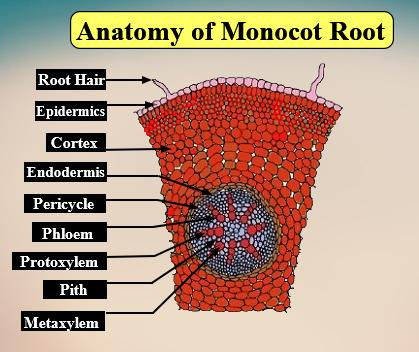
Exarch xylem is found in
A. Root
B. Stem
C. Leaf
D. Rachis
Answer
497.4k+ views
Hint: Exarch xylem is found in the plant organ that helps in the absorption of water from the soil. In some species of plants, this structure has fungal associations known as mycorrhiza. Nitrogen-fixing bacterias like Nostoc, Rhizobium, etc form symbiotic associations with this structure.
Complete answer:
Exarch refers to a type of arrangement of vascular bundles where:
-The protoxylem or first formed xylem lies peripherally.
-The metaxylem or second formed xylem lies centrally.
-The development of vascular bundles in centripetal type.
Exarch xylem is found in both dicot and monocot root systems.
Additional Information: The anatomy of dicot and monocot root is as follows:
-Epiblema or Rhizodermis layer: It consists of living tubular components and is the outermost part. No cuticle and stomata are present. Root hairs arise from the maturation zone of epiblema. It helps in water absorption from the soil.
-Cortex: The cortex is made up of circular and polygonal parenchymatous cells, intercellular spaces are present.
-Endodermis: This layer is the innermost part and has Casparian strips. It is single-layered.
-Pericycle: It is composed of parenchymatous cells and consists of only one layer. The endogenous origin of roots occurs from the pericycle layer.
-Vascular Bundles: Contains xylem and phloem in radial and exarch fashion in dicots and monocots.
-Pith: it is present at the center and it is reduced or underdeveloped in dicot root but well developed in monocot root.
So, the correct answer is,” Exarch xylem is found in the root.”
Note: Even though xylem in both monocot and dicot root lies in exarch pattern, in monocots, xylem is present in polyarch(more than six in number) condition but the number of xylem bundles ranges from two to six in dicots, which means in dicot xylem is in diarch to hexarch condition. A parenchymatous layer is present between xylem and phloem, which is known as conjunctive tissue. The conjunctive tissue produces vascular cambium during secondary growth in dicots but not in monocots.


Complete answer:
Exarch refers to a type of arrangement of vascular bundles where:
-The protoxylem or first formed xylem lies peripherally.
-The metaxylem or second formed xylem lies centrally.
-The development of vascular bundles in centripetal type.
Exarch xylem is found in both dicot and monocot root systems.
Additional Information: The anatomy of dicot and monocot root is as follows:
-Epiblema or Rhizodermis layer: It consists of living tubular components and is the outermost part. No cuticle and stomata are present. Root hairs arise from the maturation zone of epiblema. It helps in water absorption from the soil.
-Cortex: The cortex is made up of circular and polygonal parenchymatous cells, intercellular spaces are present.
-Endodermis: This layer is the innermost part and has Casparian strips. It is single-layered.
-Pericycle: It is composed of parenchymatous cells and consists of only one layer. The endogenous origin of roots occurs from the pericycle layer.
-Vascular Bundles: Contains xylem and phloem in radial and exarch fashion in dicots and monocots.
-Pith: it is present at the center and it is reduced or underdeveloped in dicot root but well developed in monocot root.
So, the correct answer is,” Exarch xylem is found in the root.”
Note: Even though xylem in both monocot and dicot root lies in exarch pattern, in monocots, xylem is present in polyarch(more than six in number) condition but the number of xylem bundles ranges from two to six in dicots, which means in dicot xylem is in diarch to hexarch condition. A parenchymatous layer is present between xylem and phloem, which is known as conjunctive tissue. The conjunctive tissue produces vascular cambium during secondary growth in dicots but not in monocots.


Recently Updated Pages
Master Class 9 General Knowledge: Engaging Questions & Answers for Success

Master Class 9 English: Engaging Questions & Answers for Success

Master Class 9 Science: Engaging Questions & Answers for Success

Master Class 9 Social Science: Engaging Questions & Answers for Success

Master Class 9 Maths: Engaging Questions & Answers for Success

Class 9 Question and Answer - Your Ultimate Solutions Guide

Trending doubts
State and prove Bernoullis theorem class 11 physics CBSE

Who built the Grand Trunk Road AChandragupta Maurya class 11 social science CBSE

1 ton equals to A 100 kg B 1000 kg C 10 kg D 10000 class 11 physics CBSE

State the laws of reflection of light

One Metric ton is equal to kg A 10000 B 1000 C 100 class 11 physics CBSE

Difference Between Prokaryotic Cells and Eukaryotic Cells




